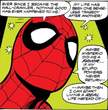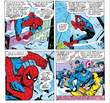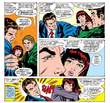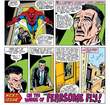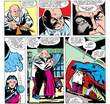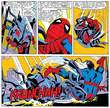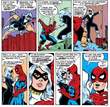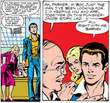Run Review: Marv Wolfman
The late-70s, early-80s are an interesting period in Spider-Man’s existence. In the post-Stan Lee period, most fans fondly remember Amazing Spider-Man runs by Gerry Conway and Roger Stern. However, modern readers give so little attention to the three runs in between that casual fans would probably be surprised that they even exist. A few years ago, I covered the unfortunately late Len Wein’s consistently solid run on the title in Run Review: Len Wein. After a few years of scavenging for a complete collection, I will examine Wolfman’s subsequent, more eccentric run on Amazing Spider-Man.
Like Wein, Marv Wolfman is well-respected for his runs on other titles while his Amazing run is generally overlooked. Perhaps his best-known run is on Teen Titans with the incomparable George Perez, which comes directly after his fairly short Spider-Man run. Many also recall his tenure on Tomb of Dracula as being good. Nevertheless, I haven’t read either run, but I want to make the point that Wolfman certainly isn’t an obscure creator, making the lack of attention around his Spider-Man work especially odd. Also like Wein, Wolfman was even Editor-in-Chief at Marvel for a short period of time.
Although Len Wein and Marv Wolfman were partners-in-crime (writer Sean Howe refers to them as the singular entity “LenMarv” in the brilliant Marvel Comics: The Untold Story), their runs could not be more dissimilar. Throughout his writing career in the late-70s, Wein demonstrates a certain perfectionism toward his craft, a perfectionism that sometimes stifles creativity. His plots are flawlessly paced with dialogue that can be almost too pristine. Wein’s precision in storytelling makes reading his work technically pleasing, and his stories are consistently well-constructed. Nevertheless, this preoccupation with the mechanics of storytelling is the ultimate downfall of Wein’s Spider-Man work, as he fails to deliver many innovative, creative ideas. His characters and scenarios are often recycled and improved on from past writers. Further, this perfectionism prevents him from taking many creative risks with major payoffs.
Much to my surprise, however, Wolfman’s tenure on the run is like an untamed beast in comparison to his colleague’s. To call this run a mixed bag would be an understatement, and I found myself utterly confused by how violently the quality shifts throughout the course of his twenty-three issue run (plus an annual). His run opens quietly with ASM #182 and unsatisfactorily dies with ASM #204. But, between these lackluster points, Wolfman constructs some truly brilliant Spider-Man stories.
While Len Wein begins and ends his run with his best stories, Wolfman isn’t nearly as calculated with his work. He begins with a mediocre two-parter about the Rocket Racer of all character. Of course, this is the infamous story that introduces Big Wheel, the idiotic character that loses control of the literal wheel in which he rides and drowns himself. In the modern comic book industry, writers view their opening story as their most important, making a big splash with a bold statement. In the late-70s, Wolfman opens up with a painfully middle-of-the-road tale featuring a main villain constantly calling people “turkey.” In retrospect, the reason for such a slow start is understandable: Wolfman wanted to test the waters and get used to Spider-Man before writing anything truly significant. In Comics Creators on Spider-Man, he explains, “I wanted to put Spider-Man through his paces first to see if I would write the character.” This easing into the character was certainly more feasible in the pre-Internet age, before readers would form and loudly project their oh-so-valuable opinion about a creator’s work before the first story arc even concludes. In hindsight, the story makes sense, even if it is a bit disorienting.
Luckily, the more serious stories do come fairly soon after Wolfman gets a hang of Spider-Man’s dialogue and character-driven plots. His run is notable for being the first that goes “back to the basics.” This concept seems to constantly rear its head after decades of Spider-Man stories, most notably with the Howard Mackie/John Byrne train wreck (that was so bad that I gave up writing a run review on it), Brand New Day, and even Marvel Legacy. Funny enough, the character was still fairly young when Wolfman took over. His predecessors largely followed the status quo that Stan Lee and John Romita established, depicting the adventures of the attractive, socially active college student, Peter Parker. By modern standards, Parker was still thriving in “the basics” when Wolfman inherited the title. But, classic Spider-Man in his perspective refers to the angsty Lee/Ditko stories, and he is one of the few major Spider-Man writers to make a concentrated effort to revive the tone of that often-misremembered run.
I say “often-misremembered” because many writers claim they’re capturing the Lee/Ditko run while almost always missing the mark. For example, Robbie Thompson’s recent Spidey run, while set in Peter’s high school days, fails to reproduce the adolescent angst and generally bleak tone that Steve Ditko brought to Peter’s social life. Thompson’s plots are too simplistic and low-stakes to compare to Ditko’s intricately-woven, fast-paced tales. Above all, none of the artists on Spidey successfully capture Ditko’s style of awkward body contortions and overwrought, near-psychotic facial expressions.
Where Thompson fails (although his Spidey series is still a solid read), Wolfman demonstrates a keen understanding of what makes the Lee/Dikto run work. How successfully he implements this knowledge varies. Easily, the element that best translates to Wolfman’s run is Spider-Man’s slightly neurotic inner monologues. Often, the hero goes web-slinging after upsetting interactions with the supporting cast, and readers are treated with a page or two of nervous, self-doubting inner thoughts conveyed through crowding thought balloons. Wolfman brilliantly captures the anxious, guilt-ridden quality of Stan Lee’s early Spider-Man dialogue. Some pages imitate the legendary writer’s style so well that they could pass as his own work. Perhaps the best use of this device occurs in "Requiem" as a near-mad Peter Parker mourns over Aunt May’s supposed death (which turns out to be a deception by Mysterio and the Burglar), painfully lamenting his inability to save those he loves the most. This melodrama perfectly captures the angst of Peter’s teenage years.
Another Lee/Ditko element that carries over well is the awkward, often ironic situations Spider-Man finds himself facing. Situational impediments like Peter losing adhesion in his webs and breaking his arm feel like occurrences that Ditko’s Spider-Man would confront. In a delightful Ditkoesque twist, Peter’s name isn’t called during his college graduation because he forgot to take a one-credit P.E. class. One of my personal favorites from the run is Wings of the Fearsome Fly, in which Spider-Man faces the laughably poorly-conceived Human Fly. Peter seemingly loses his mind in a blind fury after the Daily Bugle fires him, Mary Jane dumps him, and Ned Leeds decks him. In an act of escapism, he dons his Spider-Man costume and angrily scours the city for the Human Fly because he is “the only creep around I can really let loose on without tearing apart.” However, he soon realizes that his hopes have been dashed, as the police have just captured the villain. While it is possible that Wolfman simply ran out of room in his script for a battle, I think this ironic, Ditkoesque twist is perfect. Who wanted to see Spider-Man fight the Human Fly again anyways? In a meta-commentary sense, I appreciate that this twist ultimately shows the stupidity of the villain.
While these aspects work in Wolfman’s run, he comes across difficulties in depicting the supporting cast. In the Lee/Ditko run, Peter has no real friends, due to both Flash Thompson’s bullying and his own tactless handling of social situations. This may be an unpopular opinion, but I feel Ditko’s depiction of Peter’s social life truly begins to wear thin near the end of his run. Once Peter graduates high school, he should develop better social skills and mature as a character, but Ditko keeps him as a social outcast. So, I appreciate Peter’s character growth once Romita joins the book, as he develops what is easily the best supporting cast in comics. However, Wolfman’s problem in his “back to basics” concept is Peter’s relationships have evolved to a stage that he cannot easily become that Ditkoesque social outcast again. Flash is one of Peter’s best friends and a Vietnam veteran; he can’t simply become that one-dimensional high school bully again.
So, how does Wolfman finally decide to depict Peter’s social life? The unfortunate answer is that he really doesn’t figure it out in twenty-three issues, and some of his decisions are truly horrendous. Some choices work, such as Peter missing a date with Mary Jane and a surprise party thrown by his friends because he is chained to J. Jonah Jameson in ASM #192. These are the types of situations that Peter regularly deals with even in most post-Ditko runs, as his superhero responsibilities damage his social life. In a more Ditkoesque sense, Wolfman tends to make both Peter and his friends excessively cruel in a bad attempt of making the main character a social outcast. Peter suddenly redevelops his high school habit of ignoring his friends, contradicting years of character development. As he becomes more cold, his friends become more cruel. In ASM #195, Flash and Harry makes jokes as Peter (with a broken arm) drops his food tray and gets confronted by Ned Leeds. In moments like this, Wolfman’s attempt to develop the “world against Peter” narrative really falls apart. These characters’ relationships become regressive and, frankly, hard to read. Wolfman never really figures out what to do with Flash and Harry, and these two characters only really appear together randomly with little purpose. Eventually, in ASM #199, they awkwardly bury the hatchet with Peter and then go into semi-character limbo for a few years.
While Peter’s friendships suffer, his romantic life doesn’t fare much better. Early on, Wolfman decides to shelf Mary Jane after she rejects Peter’s first marriage proposal in ASM #183. Her relationship with Peter goes nowhere in Wein’s run and stifles possible romantic tension in stories, so Wolfman’s decision makes sense. Her replacement is the problem. Betty Brant, Peter’s Lee/Ditko romantic interest, returns to fill the Mary Jane-sized gap in Peter’s life. However, she is still in an unhappy marriage to Ned Leeds, and she obsessively clings to Peter in a desperate plea for intimacy. So begins the trend of Betty acting irrationally. This odd subplot should easily find resolution as Peter makes the rational decision to decisively reject Betty’s romantic aspirations. Instead, Peter cruelly strings Betty along for nearly fifteen issues, not giving her a clear answer until her husband assaults him a few times. Even in finally breaking it to Betty, Peter goes too far, seething, “You were just convenient … You showed up when Mary Jane jilted me.” This whole subplot is an awkward attempt to infuse Peter’s life with Ditkoesque romantic tension, but the character ultimately comes off like a complete jerk rather than a well-meaning blunderbuss.
Oddly, the supporting cast member that does shine in Wolfman’s run is J. Jonah Jameson. Wolfman’s overarching arc with Jonah is that his obsession with Spider-Man is slowly driving him insane. After his son’s death in ASM #190, Jonah begins a tirade like none other against Spider-Man. His vendetta pushes Robbie Robertson to quit his Bugle job in rage, and Jonah actually fires Peter. The Bugle publisher has a nervous breakdown and eventually ends up wandering the streets. The highlight story of Wolfman’s run is 24 Hours To Doomsday, in which a dying Spencer Smythe chains Spider-Man and Jonah together with a bomb. Conceptually smart, the story truly shines in the exchanges between the two characters and the obvious differences in their attitudes. Wolfman understands these characters at a fundamental level. As the bomb’s countdown is nearly complete, Jonah gives up while Spider-Man perseveres. In reflection, Jonah realizes that he ultimately hates the hero because his bravery reveals Jonah to be “just a weak and ordinary man.” This speech is reminiscent of that of ASM #10, reflecting the “back to basics” initiative. Ultimately, Wolfman understands the contrast between Jonah’s outward brashness and his inner insecurity, and this is an essential run for fans of the character.
Other characters benefit from solid character development as well. In an interesting twist, Kingpin (at least temporarily) gives up crime in ASM #197 in order to live happily with his wife, Vanessa. She gives him the ultimatum to end his criminal life in 24 hours. He ultimately runs out of time before killing Spider-Man and chooses his love for Vanessa over hate for the hero. Frankly, this feels like a final appearance of the Kingpin, and I would be completely happy if he had never appeared again (although the Kingpin stuff by Frank Miller is brilliant). Surprisingly, Robbie Robertson gets a few moments to shine. Wolfman depicts Robertson as the respectable newspaperman, refusing to publish the most biased of Jonah’s stories and quitting when Jonah’s vendetta goes too far. When Peter is mourning over Aunt May’s “death”, Robertson comforts him and recounts the death of his firstborn son. This supporting cast character often doesn’t receive the attention he deserves, but in moments like this, Robbie shines as a father figure to Peter. The main character certainly needs the guidance with the wringer Wolfman puts him through.
As Wolfman mines the Lee/Ditko era in his writing, artist Keith Pollard makes a concentrated effort to deliver Ditkoesque action and facial expressions. The Ditko inspiration is most obvious in ASM #191, in which Spider-Man’s fight with a Spider Slayer looks like it could have been taken from ASM #25. Pollard often contorts the hero’s body in awkward positions, imitating the spider-like, slightly-creepy quality of early Spider-Man. His sense of pacing and sequencing in action sequences has a Ditkoesque quality. For example, his depiction of Spider-Man’s battle with the Burglar in ASM #200 feels appropriately like an all-out Ditko brawl with equal parts overblown action and psychological drama. However, Pollard’s efforts to replicate the early Spider-Man era are often undercut by inkers. When Mike Esposito and Pablo Marcos finish his art, the Ditkoesque detail shines through. However, veteran inker Jim Mooney handles the majority of his art during the run. Mooney is certainly a fantastic inker, but he is from the Romita era. Ditko’s style relies on thin lines with precise detail, and Mooney’s distinct, thick blacks clash with this vision. Ultimately, Mooney’s inking tends to overwhelm the style of any penciller he work with, and Pollard is no exception. Still, I admire Pollard for being the first Spider-Man artist to look more towards Ditko than Romita for inspiration, foreshadowing fantastic artists like Marcos Martin and Javier Pulido.
Despite the “back to basics” concept, Wolfman has plenty of new ideas in this run. Almost immediately, Peter graduates from Empire State University. In a larger shake-up to the status quo, Peter joins the Daily Globe, and editor Barney Bushkin (whose brief first appearance is in Lee/Ditko’s ASM #27) spoils Peter with praise, clearly the polar opposite of Peter’s Daily Bugle job. Unfortunately, Wolfman ultimately fails to do much with this rival newspaper. Along with his creations of Big Wheel and the White Dragon (the latter of which I consider severely underrated), Wolfman’s biggest contribution to the Spider-Man mythos is the Black Cat. Her first appearance, ASM #194, brilliantly establishes her character as the morally-dubious possible romantic interest (much like another cat-based character). Felicia Hardy ultimately employs questionable ends for an understandable means: she doesn’t want her sick father to die in prison. The odd tension between Felicia and Spider-Man is unlike anything the main character had experienced up to that point. I have a theory that Marv Wolfman was positioning the two to be a couple before his sudden departure. At any rate, the Black Cat is easily the most significant character to debut in this era of Spider-Man history.
In keeping with the inspiration of early Spider-Man issues, Wolfman’s stories are either one-shots or two-parters, albeit with many long-running subplots. His typical plot centers around previously-established villains with enough of a twist to make his plots not completely derivative. Still, his lack of innovation makes certain issues feel kind of unnecessary, frankly. Wolfman’s two-part Mysterio story ultimately fails to use the villain’s seemingly-unlimited powers in an interesting way. Besides an interesting back-story of a nursing home scam, Quentin Beck’s return feels humdrum. Similarly, Chameleon’s return in ASM #186 does the character no favors and makes me wonder why he returned in the first place. The Electro story in the next issue is only interesting thanks to the unusual treat of Jim Starlin on art. In Amazing Spider-Man Annual #13, Wolfman delivers one of the most forgettable Doctor Octopus stories, the only saving graces being John Byrne’s artwork and a kooky plot of Peter pretending to join a gang. Wolfman’s stories aren’t all flat retreats with classic villains, but that certainly feels like his fall back between more interesting plots.
While many of Wolfman’s stories fall flat on a conceptual level, his execution on a plot level can be just as questionable. At times, Wolfman’s plotting is seriously flawed in a way that unnecessarily draws out his already-thin plots. In the aforementioned Mysterio story, Peter chases Quentin Beck from Aunt May’s nursing home to his old Forest Hills house back to the nursing home again. Frankly, there is no reason why the two needed to return to the nursing home, and the unnecessary transition of setting only serves to stretch out the plot. In the otherwise-solid Punisher team-up, Wolfman delivers a truly awful resolution to a cliffhanger in ASM #201 in which Frank Castle seemingly suspects that Peter is Spider-Man. After returning from the Daily Globe, Peter confronts the antihero and simply explains it away as him having a special deal with Spider-Man. Cornily, Punisher quickly believes him and leaves. Subsequently, Peter goes right back to the Daily Globe because Wolfman forgot he had just been there. Earlier, Peter refuses to work with journalist April Maye again. One issue and a few hours later, he happily agrees to work with her. I’m usually not the type to pick apart plots and identify every small plot hole, but many of Marv Wolfman’s plots seriously lack planning at a basic level.
Part of Wolfman’s problem is his lack of a designated editor to tidy up his scripts. As was popular in the loose, unorganized Marvel office of the 70s, Wolfman was a writer/editor. Len Wein and a few other notable writers were also writer/editors, but they could largely handle this responsibility. Wolfman really couldn’t. Amazing Spider-Man #200 is easily the most important issue of his run, as he pulls out all the stops and brings back Spider-Man’s first foe, the Burglar. The climactic fight scene between the two is beautifully orchestrated and emotionally rich, as Peter rips off his mask and reveals his identity to show why he is so upset with the Burglar. However, this important scene is undermined by some truly awful dialogue from the Burglar. The character uses the words “punk,” “kid,” and “creep” so often that it distracts from the dramatic tension. Any good editor would have read the script and drawn plenty much-needed red lines, but Wolfman doesn’t catch his own mistakes. Further, a solid editor could have prevented the worst issue of the run, ASM #203, from ever happening. This mess follows a fight between Spider-Man and the Dazzler that is uninspired with awful pacing and laughably bad, corny dialogue. Honestly, it amazes me that train wrecks like this ever got into print, and this run is proof that Editor-in-Chief Jim Shooter was right: comic book writers shouldn’t be their own editors.
While Wolfman’s run begins slowly, its end is sudden enough to give readers whiplash. In the middle of his second Black Cat story, Wolfman suddenly drops the title. I don’t know the exact circumstances but I guess his departure was either due to frustrations with Shooter’s opposition to writer/editors or maybe just a better deal from DC. Either way, following editor Denny O’Neil was left with a mess of unresolved plot thread to wrap up. David Michelinie finishes the Black Cat story, turning the semi-villain into a naïve Spider-Man fangirl. (Luckily, Roger Stern later retcons this as Felicia putting up an act.)
While Michelinie only needed to finish up an single story arc, Stern was left with the near-impossible job of concluding the “Jonah gone mad” subplot that Wolfman was building throughout his entire run. As the story goes, the transition between Wolfman and O’Neil’s runs was so chaotic that Marvel editorial missed an issue and forgot about the Jonah subplot. In O’Neil’s debut issue, Jonah is running the Daily Bugle, completely normal again. Somebody realized they had made a mistake and frantically called Stern to wrap up the subplot. Supposedly, John Byrne drew the whole issue in a week or so. Stern’s script is clever and well-crafted, even if the overly-tidy resolution to this year-long plot is unsatisfying. I have seen fans blame Stern for the disappointing ASM #206, but he frankly did the best he could in the dire circumstances. If anything, Wolfman should be blamed for irresponsibly departing the title that he both wrote and edited seemingly with little notice.
Ultimately, Marv Wolfman’s Spider-Man run is complicated. His stories shine when he focuses on character-driven plots, and his best stories are compelling page-turners. He hits his stride from ASM #191 to #200, and I highly recommend this short period to any Spider-Man fans. (Luckily, most of this has been reprinted recently by Marvel.) However, the rest of Wolfman’s run ranges from mediocre to awful. In many ways, Wolfman takes more creative risks than his predecessor, but this occasional, raw creativity comes at the price of inconsistent quality. Despite his attempt to replicate the Lee/Ditko era, he doesn’t capture the consistency of those early stories. He never seems to fully grasp the rhythm of a good Spider-Man story, and he never truly figures out how to handle the supporting cast. Ultimately, Wolfman’s sudden departure leads to disappointing resolutions to his long-running subplots, so reading his run all at once is unsatisfying. As a whole, I give Marv Wolfman’s run 2.5 webs out of 5.

